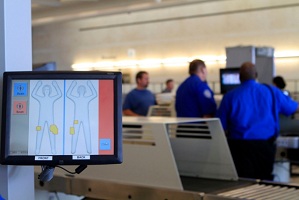A full-body scanner that the Transportation Security Administration hopes can speed up airport security checkpoints must go back to the drawing board for software to protect the privacy of travelers being scanned. The scanner, built by British firm Thruvision, was promoted as being able to simultaneously screen multiple airport passengers from a distance of up to 25 feet away. The TSA began trying out the device last year at an Arlington, Va., testing facility before planning to use it on a trial basis at U.S. airports.
But now the federal agency is requiring the scanner to add a “privacy filter” before the TSA can test the scanner “in a live environment,” according to a TSA document.
The March 26 document was posted on a public website, but many details were redacted, including the name of the manufacturer and the cost of adding the privacy filter. In a statement, Thruvision confirmed that the TSA document referred to the Thruvision scanner, which is currently being used at some Los Angeles subway and light-rail stations.
TSA and Thruvision said the software is being added to comply with a federal law passed in the wake of a 2013 controversy involving body scanners that may have shown too much.
The scanner doesn’t violate travelers’ privacy or show details of a person’s anatomy, Thruvision Americas Vice President Kevin Gramer said.
Images provided by Thruvision show that the scanner creates a fuzzy, green image depicting a traveler’s body with a dark outline of potential weapons or explosives that are hidden under their clothes. “A piece of narrowly drawn legislation from several years ago created a requirement that all people-screening technologies used at U.S. airport checkpoints have a privacy filter regardless of the image displayed,” Gramer said in a statement. “Thruvision screening equipment has been deployed internationally for years because of the tremendous privacy and safety benefits of its passive terahertz technology and it is a candidate for use at U.S. airports specifically because of those benefits.”
In 2013, the TSA removed about 200 full-body scanners after protests because the scanners used low levels of radiation to create what resembles a nude image of screened passengers. Critics called the device the “nudie scanner” before the TSA ended its contract with the manufacturer. The existing full-body scanners used at U.S. airports bounce millimeter waves off passengers to spot objects hidden under their clothes. But Gramer said the Thruvision device uses a passive terahertz technology that reads the energy emitted by a person, similar to thermal imaging used in night-vision goggles.
Thruvision has promoted its scanning devices as being able to screen up to 2,000 people in an hour and detect a concealed weapon at a distance of up to 25 feet. The screening device was used in 2017 to scan people attending a tribute concert organized by U.S. singer Ariana Grande after her May 22, 2017, concert in Manchester, England, ended in a suicide bombing that killed 23 people and wounded 139 others.








